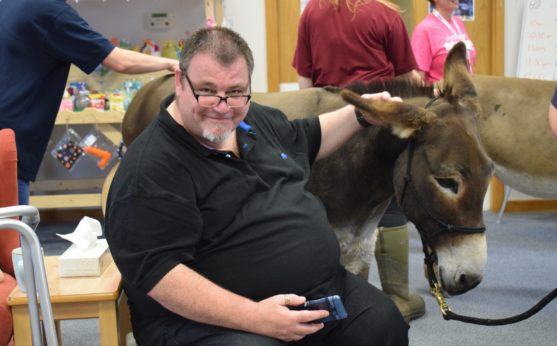Pet therapy is not new, but staff went one step further than traditional ‘pat’ dogs when donkeys first came onto the In-Patient Unit.
Research shows that stroking an animal can be calming and can reduce blood pressure for a short time. It can release endorphins, the chemicals which can suppress our response to pain.
One thing that certainly happens when an animal strolls into a room is that it lifts the mood, and within seconds it has started a dozen chats, and a lot of laughter.
Our Medical Director Dr Susan Salt introduced donkey therapy to Trinity after hearing of its use with dementia patients.
She says: “There are several good things going on when a patient meets an animal. Some miss the companionship of a pet when illness strikes; they miss the daily dog walk and the feeling of being needed.
“Some people talk to animals when they might not feel like talking to a human. Patients may have worries about their illness but a few minutes with a pet – their own or someone else’s – can make a positive difference to their outlook.”
Trinity has welcomed horses (too big for the Unit, but happy in the Hospice gardens), barn owls, a pygmy hedgehog called Florence and all the pets who visit our patients; from dogs and cats to cockatoos (but not at the same time!).
Dr Susan adds: “Sometimes you don’t need scientific proof about the benefit of a therapy; simple observation is enough. The sight of a patient being greeted by their dog after a separation can be wonderful, and I have seen very ill patients get up and go to meet the donkeys.
“Serious illness can isolate and cause overwhelming feelings of stress, but I have seen those things dissipate the moment an animal – from a house trained donkey to a friendly hedgehog – enters the room.”


